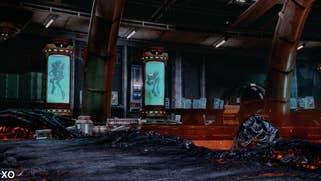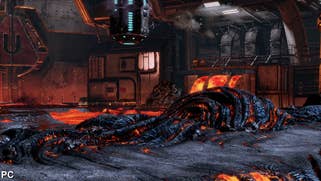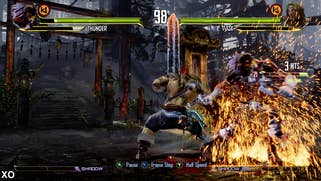Face-Off: Killer Instinct on PC
Killer conversion or dead on arrival?
Ports from Xbox One to PC are rapidly moving forward as Microsoft aims to converge the two platforms into one. Cross-system play, transferable save data and a unified online player base are the key highlights in this approach. Killer Instinct seems like a natural fit for this system, and for the most part the translation over to PC has gone fairly smoothly, though not without a few minor issues. UWP troubles still crop up with download errors and occasional crashes during gameplay, but thankfully not to the extent that we saw with Gears of War Ultimate Edition.
But on a core visual level how much has actually changed from the Xbox One release with the move to an evolving platform offering up vastly more powerful hardware? Well, Killer Instinct is geared towards a 60fps update, with gameplay synced to output correctly at that refresh rate, and this seems to have played a large role in shaping the PC version. Unlike many cross platform titles that take advantage of more powerful PC hardware to deliver a sizeable leap in graphical quality, here the developers focus on keeping system requirements low, allowing users to easily hit 60fps on modestly-specced systems. The idea is to open up the game to as many players as possible - not just those with expensive PCs.
As a result the same core assets and effects work are present across Xbox One and PC. A number of graphical settings are available to configure, ranging from texture and shadow quality, to toggle options for anti-aliasing and motion blur. But these only allow us to reduce quality levels below the Xbox One game, with resolution the only major upgrade path on offer. The maxed-out PC experience essentially boils down to just one upgrade - slightly improved texture filtering - leading to detail appearing clearer when viewed from oblique angles. It's a minor enhancement, mainly noticeable across the ground during intros and post-fight sequences, where fine detail in these areas tends to pop out a little more.
On the plus side, Killer Instinct remains a great-looking release. The lighting model adds a nice layer of atmosphere and depth to environments, while particle physics remain a high point with plenty of sparks flying across the stage when special moves make contact. Shadow quality is also solid too, and these elements appear smooth. The excellent visuals on offer receive a boost at higher resolutions, adding more clarity and sharpness to the presentation. Of course, Xbox One's 900p set-up still holds up well against PC running at 1080p. There's more shimmering around sub-pixel elements like weapon details and jewellery worn by the characters, but imagery is generally very crisp, and it never feels like the art and effects work are overly compromised by the sub-native resolution.
That said, black crush is still an issue on Xbox One, even when outputting the correct rec.709 colour space in limited range to a display that natively supports this standard - and this is the way Microsoft recommends games to be output on Xbox One. Something still doesn't seem to be right here. This isn't a problem on the PC version, which retains a balanced level of contrast and shadow detail. Ultimately, this more accurate image brings out more depth from the artwork.
Killer Instinct is designed to operate at 60fps. However, many PC users run monitors that operate at 120Hz or faster. Unfortunately, the renderer in Killer Instinct is hard-set to a 60fps update, and any deviations from that completely breaks the gameplay. For example, when playing at 120Hz the game runs at twice the speed, while conversely if the hardware cannot sustain 60fps then the action slows down rather than dropping frames. We truly pity any one with one of the early 4K 30Hz screens trying to run this game.
Microsoft is looking into offering proper support for high frequency displays, but for now the solution for those with 120Hz (or above) monitors is to set the desktop refresh rate to 60Hz. This makes the game run at the correct speed, but may introduce judder if your monitor doesn't natively support a 60Hz refresh.
So, obviously the key here is to hit 60fps at all times - so what does it take to consistently hit 1080p60? Thankfully, this can be done on fairly low-end hardware. A Core i3 processor combined with either a GTX 750 Ti or Radeon R7 360 mostly delivers a solid 60fps, with performance only briefly impacted when particles and alpha effects start flying. We're only a few frames away from target, and a modest overclock should be enough to seal the deal. Of course moving up to a GTX 950 and R7 370 should guarantee a locked frame-rate, and with higher resolutions, it's simply a case of scaling up graphics hardware until you get hit that target.














Killer Instinct: the Digital Foundry verdict
All told, Microsoft has handed in a solid port of Killer Instinct and while the game doesn't deliver a major graphical overhaul over the original Xbox One release, the visuals remain striking and scale up nicely to resolutions beyond the console's 900p presentation. The extra pixel fidelity at 1080p and beyond, correct gamma output, and better texture filtering are all enough to show the game in a better light. The low hardware requirements also mean that getting a perfect 60fps is in easy reach for budget PC builds, and ensures that the experience is consistent for as many players as possible.
The lack of support for high frequency displays will disappoint those who enjoying playing at extremely high frame-rates, but it's not entirely surprising that this feature doesn't work with Killer Instinct, given that the internal workings of the game are intricately tied to a 60fps update. Thankfully, most monitors run at 60Hz, so this will only impact a tiny minority - but regardless, it's frustrating that the developer has forgotten that PC gamers want to scale their experience, and that goes beyond resolution alone.
Overall, on a technical level, Killer Instinct on PC is best version of the game, and the good news is that those who own the original Xbox One release can dive in for free. Cross-platform support for save files, replays and DLC tie the two versions together nicely, allowing users to switch platforms and continue playing without losing progress. The PC version also appears to be free from the glaring performance issues we've seen on other UWP titles. However, download and installation via the Windows store can still throw up problems, and in-game stability isn't quite a solid as it could be. There's a few niggles that need ironing out with Microsoft's content delivery system, but the game itself is sound.









